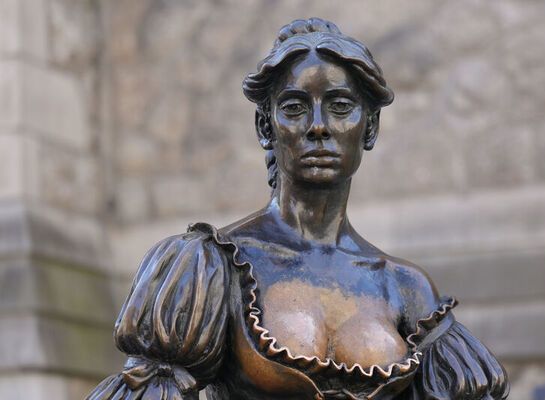By Peter McDermott
Former courts reporter Guy Sterling is normally a quiet-spoken man. But get him onto the topic of Justice William J. Brennan Jr. and he can become quite animated.
“He wasn’t just bright, he was brilliant,” said the 61-year-old of his fellow native of the city of Newark, N.J.
Sterling, who worked for the Star Ledger for 28 years, has been spearheading the local campaign to honor the son of County Roscommon immigrants who was the U.S. Supreme Court’s driving force in an era of great societal change.
“He is celebrated as somebody who could get a majority on the court,” Sterling said of Brennan, who served from 1956 through 1990. “He’d work his magic.”
On June 3, Laurence Tribe, Harvard Law School professor, Justice Department official and mentor to President Obama, will dedicate the statute at the steps of Essex County Hall of Records, where Brennan served for a time as a judge.
“We’re simply thrilled,” daughter Nancy Brennan said of the family’s reaction to the honor. “It’s so appreciated.”
Though, he found himself in Washington D.C. from his 50s on, she said that her father was always conscious of the fact that he was shaped by Newark, and he remained deeply attached to the city.
“He maintained his connection to this city,” Sterling said. “He always made time to meet with lawyers from the area when they traveled to Washington to be sworn in before the Supreme Court.”
Seth Stern, coauthor with Stephen Wermiel of the official biography “Justice Brennan: Liberal Champion” due to be published in October, agreed that it is fitting that his home city honor him. It provided the launching pad for one of the most important tenures on the high court in American history.
“He was certainly the most influential liberal and the most influential justice in the second half of the 20th century,” Stern said.
William J. Brennan Jr. was born on April 25, 1906, the second of the eight children of William J. Brennan Sr. and the former Agnes McDermott. The Brennans were both from Frenchpark, Co. Roscommon, but met for the first time in Newark.
Nancy Brennan, who was 13 when her paternal grandmother died, said she was very much the family’s matriarch.
“That was something she saw growing up: the mother ran the family,” she said.
Brennan, who is the executive director of the Rose Kennedy Greenway Conservancy in Boston, visited Roscommon with her parents as a teenager in the 1960s and went back again in the 1970s with her own daughter and once again in more recent years.
“He kept up quite a correspondence with jurists and family members he met in Ireland,” she said of her father. “It was a reconnection that meant a great deal to him until he died [in 1997].”
Beloved pol
William J. Brennan Sr., who worked as a metal polisher and shoveled coal, rose through the ranks of labor and New Jersey politics.
“Justice Brennan’s philosophy stemmed from the fact that when his father was running for office, the police would break into his apartment at 2 in the morning,” Sterling said.
He had also battled officers as a labor activist. But in 1917, with a change of power, he became responsible for both the police and fire departments in Newark as the commissioner of public safety.
“‘Big Bill,’ as he was known, became loved by police for demanding that his officers be paid squarely and fairly,” journalist and author Kim Isaac Eisler has written. “He was loved by the citizenry for stubbornly insisting that proper police procedures be employed and that the use of the truncheon be ended.”
In 1925, the father of the future judicial champion of affirmation action appointed the city’s first black officers.
Brennan contracted pneumonia in 1930 and died days later. Thousands attended the funeral of the 57-year-old Roscommon native. “My grandfather must have been an amazing man — not to be born in this country and to be loved by so many people,” Nancy Brennan said.
William J. Brennan Jr. graduated from Harvard Law School the following year. Wall Street law firms generally didn’t recruit Catholics at the time, but the local Newark firm Pitney Hardin were looking to diversify and took him on. He stood out in another way: as a graduate of the University of Pennsylvania, he was the firm’s only lawyer who hadn’t been to Princeton.
“To overcome his immigrant Irish background, Brennan occasionally needed help,” Eisler wrote in an obituary. “Despite a level head and great intelligence, the world did not rush to his feet.”
Brennan worked in the area of industrial relations on the side of the corporations, but because of his polite manner and his heritage, Eisler said, his union opponents believed he was “secretly in sympathy with the working man.”
Nothing, however, in his record as a lawyer in private practice or as a judge in New Jersey marked him as anything other than a conservative Democrat. When the Eisenhower administration decided to appoint a Catholic to the high court, he seemed like a safe choice. Instead, Brennan turned out to be the most influential progressive in its history.
“It’s an extraordinary range of issues that he influenced: the first amendment, freedom of the press,” Stern said, who writes for the Congressional Quarterly. “He influenced the right to privacy and the abortion issue, which has become so controversial, affirmative action, school desegregation, the death penalty, welfare rights, voter apportionment.”
People’s judge
“He didn’t see the Constitution as a static document,” Sterling said.
The former newspaperman and his allies commissioned sculptor Thomas Jay Warren to do an 8-foot statue of Brennan.
“Honoring a person such as this is the most fulfilling aspect of my work as a sculptor,” said Warren, a New Jersey native who is now based in Rogue River, Ore.
“Finding out about the true quality of Brennan’s character, as a judge who put the needs of the common man first, inspired me to immediately start work on his portrait and a maquette for the full statue,” the sculptor said, “even though there was no assurance that the project would come to fruition or even get off the ground. It was the first time in my 26-year career that I had done that.”
“He’s looking to the left,” said Sterling, viewing the maquette of the statue recently in the offices of Essex County Executive Joseph DiVincenza, an early ally of the project. “He’s really captured the face.
“This was a no-nonsense guy,” he said. “You can tell just by looking at him.”
DiVincenza told Sterling and his allies that he’d back the statue proposal if they could raise the funds — $130,000 — from private sources.
“So we’ve been in overdrive since then,” said Sterling, whose mother’s family is from Ballybunion, Co. Kerry.
The committee has gotten money from sources ranging from former Bill Clinton advisor Vernon Jordan to the Roscommon Society of New York, which donated $500.
“I’ve named three plazas after people,” DiVincenza said, referring to Governor Brendan Byrne, Congressman Donald Payne and Rosa Parks. “This is the first statue. Guy tells me what to do and I follow.”
“You did your homework, and came back to us three weeks later,” Sterling said.
“I’m very proud of the issues Justice Brennan fought for,” replied DiVincenza, who like Brennan went to Barringer High School.
Nancy Brennan said her father’s approach to such issues was strongly influenced by Catholic thinking on social justice.
“He wasn’t just a first-rate jurist, he had good norms and values,” she said, adding with a laugh: “But I might be slightly prejudiced.”
(PHOTO BY PETER MCDERMOTT Guy Sterling, left, and Essex County Executive Joseph DiVincenzo with a maquette of the 8-foot statue (with pedestal) of Justice Brennan that will be unveiled on June 3 outside the Essex County Hall of Records in Newark.)









